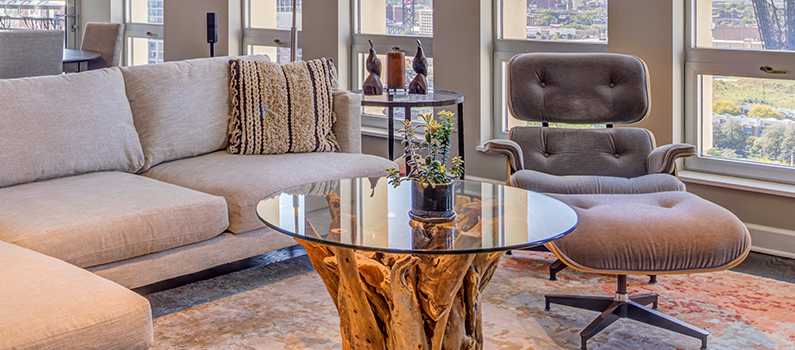As we think about the various phases of interior design, I’m happy to say we now have the power to think about doing no harm. Below are few factors that can amp up your Earth Day power by decreasing waste from remodeling, renovating and redecorating, and some points to consider when you are going to buy new.
The power of reusing: The easiest way to help our planet is to reuse rather than replace. For example, could you paint the cabinetry instead of ripping it out, throwing it into a landfill and buying new?
The bathroom on the left below used to have bland wood cabinetry that looked dated. By painting the vanity a high-gloss taupe, which coordinated with the existing floor tile, we completely updated the room. The bath on the right is in a vintage building dating to 1929. The homeowner was very interested in reusing rather than replacing. Thus, we reused the toilet, resurfaced the existing vintage tub, and even reused the existing body sprays (yes, from the late 1920s) by having them re-chromed and reinstalled.

Reusing works for furniture as well. It’s just not right to dismiss the possibility of giving new life to old things! In fact, much of design is integrating the new with the old. The photo below shows a corner of a living room we did. To achieve the look, we refashioned the arms and legs of an existing sofa and reupholstered it in a beautiful soft blue leather. We reupholstered the cushions of the existing contemporary Barcelona chair, and the homeowner had already refinished her Biedermeier-style table. We pulled it together with a very contemporary wool rug since wool is a sustainable fiber.

The power of repurposing: It’s fun to consider new possibilities for older furnishings. Would that antique dresser be an interesting bathroom vanity? With a few modifications, a vintage dresser can be made into a useful vanity, adding unique character to your space.

The power of donating: If you do have to remove furnishings in your home to get the look you want, donate items to not-for-profits that build homes for disadvantaged populations. This does take forward planning however, as these organizations require 8-10 weeks advance notice so that they can see the items first, determine if they can use them, then schedule pickup and make warehouse space available.

The power of correct quantity: When buying materials, remeasure and recalculate before ordering. It’s a terrible shame to realize there isn’t enough tile to complete a floor, and then find the same dye-lot is no longer available, so one has to begin anew. Also, order just what is needed. Encourage contractors to measure carefully and buy only what is needed, rather than de-facto buying 10 percent to 20 percent more to make the job easier for them.

When there is nothing to do but purchase new, please try to keep the following tips in mind that we did when designing the living room shown below:

- Buy quality items so they last longer, and don’t get thrown into a landfill in five years.
- Buy from local sources to reduce the carbon footprint of shipping.
- Consider gently used furnishings such as the brass-and-glass side table below, which we found on the Chairish website.
- Use sustainable materials such as quartz countertops instead of natural stone, a reclaimed wood coffee table such as that seen below, and a natural wool rug.
- Use paints and wall coverings that are non-toxic and don’t release harmful gasses.
- Look for water-based, no-VOC and/or low-VOC materials when you buy wallpaper, paint, flooring, carpeting and rugs.

As you think about your next home project, we’d be delighted to help you think through where you can reuse, repurpose, or recycle. Please give us a call!



